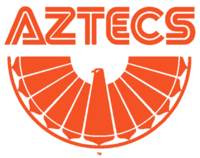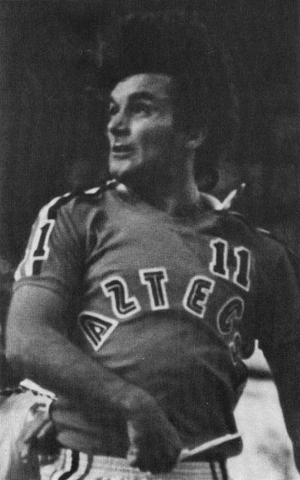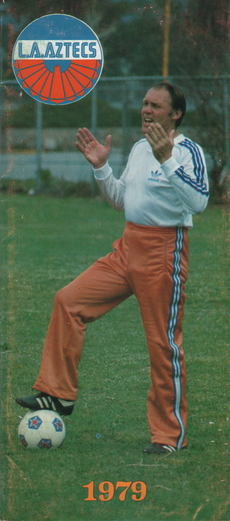Los Angeles Aztecs facts for kids
 |
|||
| Full name | Los Angeles Aztecs | ||
|---|---|---|---|
| Founded | December 11, 1973 | ||
| Dissolved | December 9, 1981 | ||
| Stadium | East Los Angeles College Stadium (1974) Murdock Stadium (1975–76) LA Memorial Coliseum (1977, 1981) Rose Bowl (1978–80) Indoor: The Forum (1979–80) LA Sports Arena (1980–81) |
||
|
|
|||
The Los Angeles Aztecs were a professional soccer team from Los Angeles, California. They played in the North American Soccer League (NASL) from 1974 to 1981. The Aztecs also played in indoor soccer seasons. They won the NASL Championship in 1974, which was a big achievement.
During their eight years, the Aztecs played in four different stadiums. They also had four different owners. Famous European soccer players like George Best and Johan Cruyff played for the team. From 1975 to 1977, the famous English singer Elton John was even a part-owner!
Contents
History of the Los Angeles Aztecs
Starting the Team and Winning the Championship
In January 1974, the NASL decided to add new teams. Los Angeles was one of six cities chosen for an expansion team. This was because more people were becoming interested in professional soccer.
A local doctor and investor named Jack Gregory became the team owner. Alex Perolli was chosen as the first head coach.
The Aztecs played their first NASL game at the East Los Angeles College Stadium. They won 2–1 against the Seattle Sounders. Over 4,000 fans came to watch. The team started the season with three wins in a row.
The Aztecs finished their first season very well. They had 11 wins, 2 ties, and 7 losses. They also had about 5,000 fans at each game. They won first place in their division, the Western Division.
A player named Doug McMillan scored eleven goals. He was named Rookie of the Year for 1974. The Aztecs then beat the Boston Minutemen 2–0 in the semi-finals.
The Aztecs had earned the right to host the championship game. However, the game was moved to the Miami Orange Bowl for TV reasons. On August 25, 1974, the Los Angeles Aztecs played the Miami Toros. The game was a 3–3 tie after regular time. The Aztecs then won in a penalty shoot-out 5–3! This made them the 1974 NASL Champions. It was amazing for a new team to win the championship so quickly.
New Owners and More Games
After their championship win, coach Alex Perolli left the team. Owner Jack Gregory also sold his part of the team. A new group led by John Chaffetz took over. They hired Terry Fisher, who was only 25 years old. He became the youngest coach in the NASL.
The Aztecs also played in the 1975 NASL Indoor tournament. They played three indoor games that year.
The outdoor season started with a 2–1 win against the San Jose Earthquakes. On July 3, 1975, the Aztecs had their first home game sellout. They beat the Pelé-led New York Cosmos 5–1. Uri Banhoffer scored three goals in that game!
The team finished the 1975 season with twelve wins and ten losses. They made it to the playoffs as a wild card team. However, they lost to the St. Louis Stars in a penalty shoot-out.
The Best Years with Famous Players
After the 1975 season, the famous English singer Elton John bought a part of the team. The league even let him sit on the bench during games! A few weeks later, the team announced they wanted to sign George Best. He was a very famous player who had won the 1968 Ballon d'Or award.

George Best arrived in Los Angeles in February 1976. The Aztecs lost their first game of the 1976 season. But Best scored his first goal for the team on April 25, 1976. He scored 15 goals that season. The team finished in third place in their division. They lost in the first round of the playoffs to the Dallas Tornado.
For the 1977 season, the team moved to the L.A. Coliseum. On July 3, 1977, a huge crowd of 32,165 fans came to watch the Aztecs play the Cosmos. This was Brazilian superstar Pelé's last game in Los Angeles. The Aztecs won the game 4–1!
The Aztecs finished the 1977 season with fifteen wins and eleven losses. They made it to the Conference Championships. But they were defeated by the Seattle Sounders.
After the season, a new group led by Alan Rothenberg bought the team. They also signed a deal to play home games at the Rose Bowl. During this time, rumors started about George Best's lifestyle. He missed practices and was suspended. The team later traded him to the Fort Lauderdale Strikers.
The team changed coaches a few times during the 1978 season. They finished in last place in their division. This was the only outdoor season where the Aztecs did not make the playoffs.
The Michels and Cruyff Era

In November 1978, the team hired Rinus Michels as head coach. He was a very famous coach from Europe. He had managed teams like FC Barcelona and the Dutch national team. Michels changed almost the entire team. Only four players from 1978 stayed for the 1979 season.
The Aztecs started the 1979 season with five wins in seven games. Then, on May 22, 1979, the team signed Johan Cruyff. He was another incredibly famous player, who had won the Ballon d'Or three times! Cruyff became the highest-paid athlete in Southern California.
The Aztecs finished the season with eighteen wins and twelve losses. Before Cruyff joined, about 7,500 fans came to games. After he signed, the average attendance jumped to over 14,000 fans! The Aztecs beat the Washington Diplomats in the first round of the playoffs. They then played the Vancouver Whitecaps in the Conference Semifinals. The Aztecs won one game but lost the series.
Johan Cruyff was named the league's Most Valuable Player (MVP) for 1979. Larry Hulcer was named Rookie of the Year.
In early 1980, a Mexican media company called Televisa bought the team. They sold Johan Cruyff's rights to another team to save money. The Aztecs also played in the 1979–80 NASL Indoor season, but they only won two games.
Coach Michels almost left the team before the 1980 outdoor season. But he reached an agreement and stayed. The Aztecs finished the 1980 season with twenty wins and twelve losses. They made it to the Conference Championships again. But they were defeated by the New York Cosmos. Less than a month later, Michels left the team for a job in Germany.
The Final Season
The Aztecs had their best indoor season in 1980–81 NASL Indoor season. They won eleven games and finished first in their division. However, they were eliminated in the first round of the playoffs.
On January 9, 1981, the Aztecs announced Cláudio Coutinho as their new coach. The team also moved back to the Los Angeles Memorial Coliseum for their home games. The Aztecs finished the 1981 North American Soccer League season with nineteen wins and thirteen losses. They had about 5,800 fans at each game.
The team was knocked out of the first round of the playoffs by the Montreal Manic. The final game was decided by a controversial penalty call in overtime. After this season, on December 9, 1981, the team's owners, Televisa, announced that the Los Angeles Aztecs would no longer play. Any remaining player contracts were sold to other teams.
Year-by-year Records
| Year | Division | League | Reg. season | Playoffs | Open Cup | Avg. Attend. |
|---|---|---|---|---|---|---|
| 1974 | 1 | NASL | 1st, Western | Champions | did not enter | 5,098 |
| 1975 | N/A | NASL Indoor | 3rd, Region 4 | did not qualify | N/A | N/A |
| 1975 | 1 | NASL | 3rd, Western | Quarterfinals | did not enter | 8,307 |
| 1976 | 1 | NASL | 3rd, Pacific Southern | 1st Round | did not enter | 8,051 |
| 1977 | 1 | NASL | 3rd, Pacific Southern | Semifinals | did not enter | 9,638 |
| 1978 | 1 | NASL | 4th, National Western | did not qualify | did not enter | 9,301 |
| 1979 | 1 | NASL | 2nd, National Western | Conference Semifinals | did not enter | 14,334 |
| 1979–80 | N/A | NASL Indoor | 5th, Western | did not qualify | N/A | 3,152 |
| 1980 | 1 | NASL | 2nd, National Western | Conference Championships | did not enter | 12,057 |
| 1980–81 | N/A | NASL Indoor | 1st, Western | 1st Round | N/A | 3,439 |
| 1981 | 1 | NASL | 2nd, Western | 1st Round | did not enter | 5,814 |
Notable Players
 Javier Aguirre
Javier Aguirre Gary Allison
Gary Allison Lee Atack
Lee Atack Desmond Backos
Desmond Backos Phil Beal
Phil Beal George Best
George Best Željko Bilecki
Željko Bilecki Bob Bolitho
Bob Bolitho Colin Boulton
Colin Boulton Colin Clarke
Colin Clarke Martin Cohen
Martin Cohen Charlie Cooke
Charlie Cooke Julio César Cortés
Julio César Cortés Renato Costa
Renato Costa Peter Coyne
Peter Coyne Johan Cruyff
Johan Cruyff Chris Dangerfield
Chris Dangerfield Steve David
Steve David Ron Davies
Ron Davies Antonio de la Torre Villalpando
Antonio de la Torre Villalpando Roberto de Oliveira
Roberto de Oliveira George Dewsnip
George Dewsnip Angelo DiBernardo
Angelo DiBernardo Vito Dimitrijević
Vito Dimitrijević Tony Douglas
Tony Douglas Gary Etherington
Gary Etherington Bernie Fagan
Bernie Fagan Mike Ferguson
Mike Ferguson Santiago Formoso
Santiago Formoso Randy Garber
Randy Garber Poli Garcia
Poli Garcia Steve Gay
Steve Gay Uruguay Graffigna
Uruguay Graffigna Austin Hayes
Austin Hayes Graham Horn
Graham Horn Larry Hulcer
Larry Hulcer Alan Jones
Alan Jones Garry Jones
Garry Jones Jerry Kazarian
Jerry Kazarian Alan Kelley
Alan Kelley Jimmy Kelly
Jimmy Kelly Mihalj Keri
Mihalj Keri György Kottán
György Kottán Bob Lenarduzzi
Bob Lenarduzzi Dave Lennard
Dave Lennard Malcolm Linton
Malcolm Linton Sammy Llewellyn
Sammy Llewellyn Miguel Lopez
Miguel Lopez Luís Fernando Gaúcho
Luís Fernando Gaúcho Terry Mancini
Terry Mancini Jackie Marsh
Jackie Marsh John Mason
John Mason Bobby McAlinden
Bobby McAlinden John McGrane
John McGrane Mike McLenaghen
Mike McLenaghen Doug McMillan
Doug McMillan Alan Merrick
Alan Merrick Ramón Mifflin
Ramón Mifflin Ane Mihailovich
Ane Mihailovich Jim Millinder
Jim Millinder Bill Mishalow
Bill Mishalow Ramon Moraldo
Ramon Moraldo Dave Morrison
Dave Morrison Buzz Parsons
Buzz Parsons Hugo Pérez
Hugo Pérez Héctor Pulido
Héctor Pulido Brian Quinn
Brian Quinn Luiz Rangel
Luiz Rangel Tom Reynolds
Tom Reynolds Bob Rigby
Bob Rigby Andy Rolland
Andy Rolland Rubén Omar Romano
Rubén Omar Romano Thomas Rongen
Thomas Rongen Alex Russell
Alex Russell Miro Rys
Miro Rys Todd Saldana
Todd Saldana Bill Sautter
Bill Sautter Dave Shelton
Dave Shelton Bobby Sibbald
Bobby Sibbald Dave Smith
Dave Smith Tommy Smith
Tommy Smith Franciszek Smuda
Franciszek Smuda Frantz St. Lot
Frantz St. Lot Wim Suurbier
Wim Suurbier Chris Turner
Chris Turner Juli Veee
Juli Veee Leo van Veen
Leo van Veen Sergio Velazquez
Sergio Velazquez Scott Vorst
Scott Vorst Walter Wagner
Walter Wagner Rudy Ybarra
Rudy Ybarra
Team Ownership
- Dr. Jack Gregory – Founder / co-owner
- Elton John – co-owner (1975–1977)
- Alan Rothenberg – owner (1977–80)
- Televisa – owners (1980–1981)
Team Honors and Awards
NASL Championships
NASL Regular Season Premierships
Division Champions
League MVP
Rookie of the Year
League Scoring Champion
League Goal Scoring Champion
League Assists Leader
Indoor All-Stars
|
All-Star First Team Selections
All-Star Second Team Selections
All-Star Honorable Mentions
U.S. Soccer Hall of Fame
Canadian Soccer Hall of Fame
Indoor Soccer Hall of Fame
|
Images for kids
-
Head coach Rinus Michels ahead of the 1979 season
See also
 In Spanish: Los Angeles Aztecs para niños
In Spanish: Los Angeles Aztecs para niños


